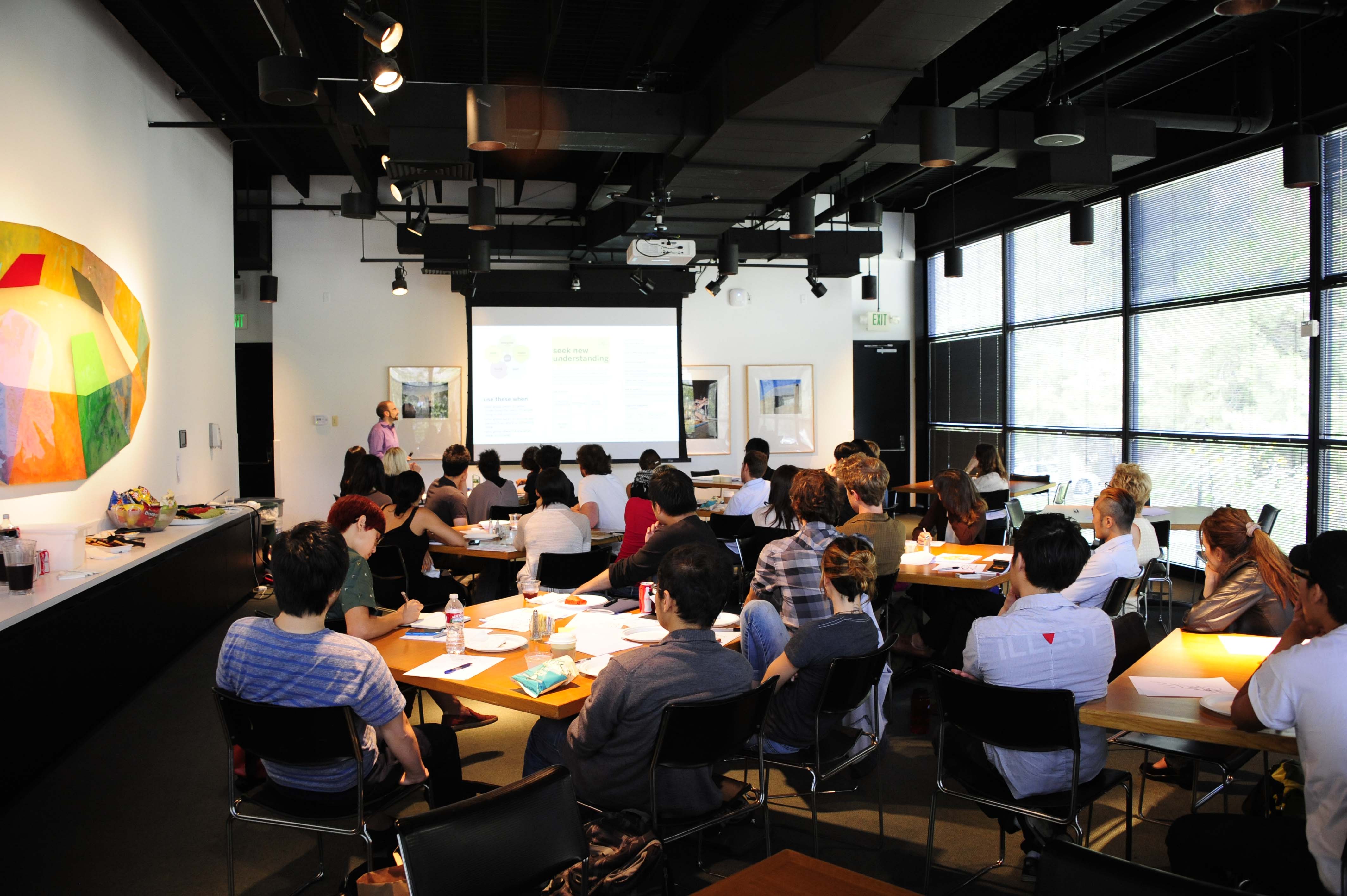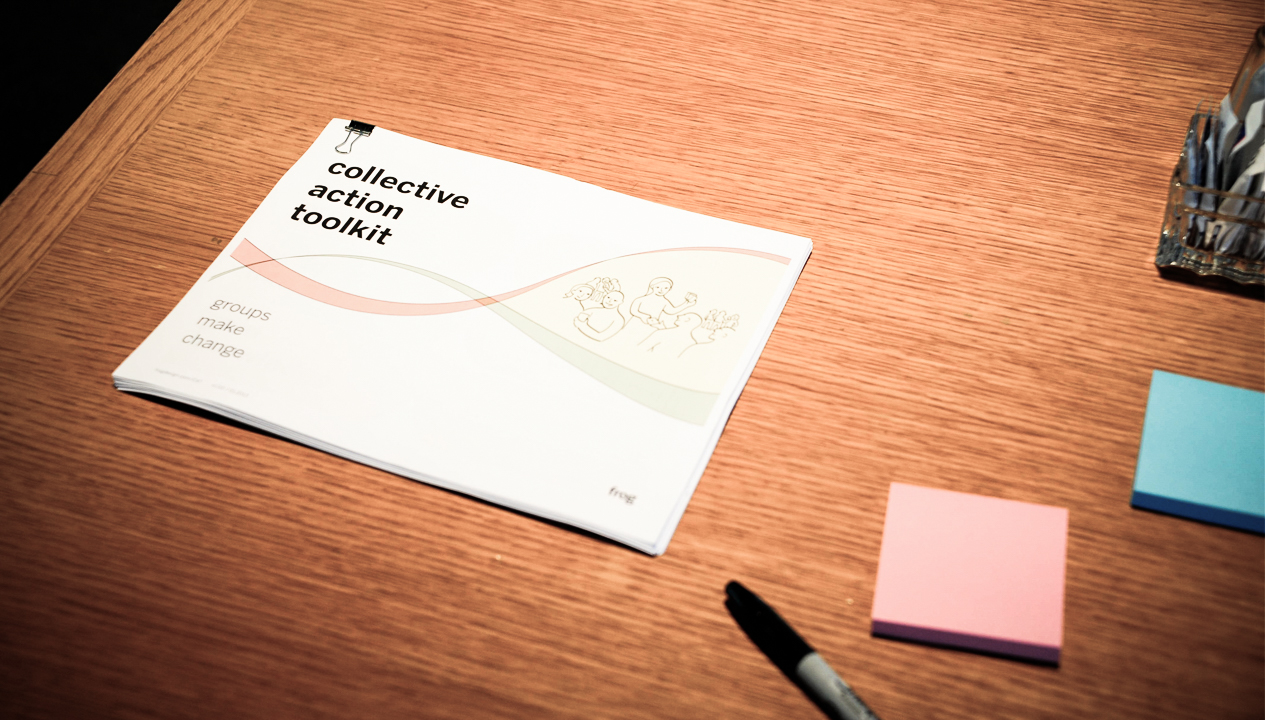Designmatters Concentration student Carolina Rodriguez (Illustration) shares her experiences participating in the frog Collective Action Toolkit Workshop presented by David Sherwin.
 On the morning of July 12, I was fortunate to be one of 30 faculty and student participants invited to a special Designmatters-hosted workshop of the “The Collective Action Toolkit”, a collation of activities that helps teams and communities organize and advance their ideas on a particular issue for the purpose of designing a community-based solution; the original kit, created by frog Design was tested on the Art Center faculty and student community. David Sherwin from frog Design welcomed all of us and asked us to find a seat After we all settled down, David asked us to introduce ourselves within the groups we formed. After getting a sense of every individual from my group, we started to organically talk about issues that were on our minds. My group immediately connected on the topic of Art Center not being as sustainable as it can be. Everyone seemed to voice some opinions about being “wasteful.” We asked a lot of questions: why does Art Center keep the A.C. on at night? How much paper do we use? How much of that is actually recycled? A lot of these questions were difficult to answer. We looked at our “action map” and immediately saw what to do next. Seek new understanding. We wrote out all the questions we kept revisiting aloud and wrote them out on sheets of paper. Then, everyone in our group tried to answer the questions individually on sticky notes. The papers that received the least amount of sticky notes (or none at all) were the questions that we wanted to pursue further. Our workshop ended soon after, but my takeaway from the workshop was a curiosity and desire to pursue and solve some of the questions we couldn’t answer as a group.
On the morning of July 12, I was fortunate to be one of 30 faculty and student participants invited to a special Designmatters-hosted workshop of the “The Collective Action Toolkit”, a collation of activities that helps teams and communities organize and advance their ideas on a particular issue for the purpose of designing a community-based solution; the original kit, created by frog Design was tested on the Art Center faculty and student community. David Sherwin from frog Design welcomed all of us and asked us to find a seat After we all settled down, David asked us to introduce ourselves within the groups we formed. After getting a sense of every individual from my group, we started to organically talk about issues that were on our minds. My group immediately connected on the topic of Art Center not being as sustainable as it can be. Everyone seemed to voice some opinions about being “wasteful.” We asked a lot of questions: why does Art Center keep the A.C. on at night? How much paper do we use? How much of that is actually recycled? A lot of these questions were difficult to answer. We looked at our “action map” and immediately saw what to do next. Seek new understanding. We wrote out all the questions we kept revisiting aloud and wrote them out on sheets of paper. Then, everyone in our group tried to answer the questions individually on sticky notes. The papers that received the least amount of sticky notes (or none at all) were the questions that we wanted to pursue further. Our workshop ended soon after, but my takeaway from the workshop was a curiosity and desire to pursue and solve some of the questions we couldn’t answer as a group.
 For me, I learned that the The Collective Action Toolkit is a resource that can be used in a variety of situations and communities amongst all sorts of age groups. I appreciated the impact a tool like this could have had during my 2 month volunteer excursion to Borneo earlier this summer. I worked closely with native Dayak people from Indonesia, and despite an obvious language barrier and many cultural differences, we all found common ground in our aim to conserve the rain forest and remaining Orangutan population of Borneo. We all worked together for a similar cause, and although we found our own methods of working on projects like building a 300 meter bridge for orangutan and human use in swampland, or constructing sun bear enclosures, or going into town to purchase various enrichment supplies for the orangutans at the Orangutans Foundation International care center; I can definitely see how the Toolkit would have expedited the silent phases that overwhelmed many of my first encounters within the community. I plan on returning to Borneo next summer for 4 months; I am definitely taking the Collective Action Toolkit with me.
For me, I learned that the The Collective Action Toolkit is a resource that can be used in a variety of situations and communities amongst all sorts of age groups. I appreciated the impact a tool like this could have had during my 2 month volunteer excursion to Borneo earlier this summer. I worked closely with native Dayak people from Indonesia, and despite an obvious language barrier and many cultural differences, we all found common ground in our aim to conserve the rain forest and remaining Orangutan population of Borneo. We all worked together for a similar cause, and although we found our own methods of working on projects like building a 300 meter bridge for orangutan and human use in swampland, or constructing sun bear enclosures, or going into town to purchase various enrichment supplies for the orangutans at the Orangutans Foundation International care center; I can definitely see how the Toolkit would have expedited the silent phases that overwhelmed many of my first encounters within the community. I plan on returning to Borneo next summer for 4 months; I am definitely taking the Collective Action Toolkit with me.
The Collective Action Toolkit is a package of resources and activities that enable groups of people anywhere to organize, build trust, and collaboratively create solutions for problems impacting their community. The toolkit provides a dynamic framework that integrates knowledge and action to solve challenges. Designed to harness the benefits of group action and the power of open sharing, the activities draw on each participant’s strengths and perspectives as the groups work to accomplish a goal.
